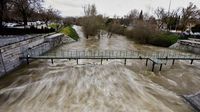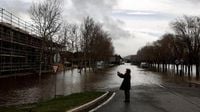Spain is currently grappling with severe flooding as a result of Storm Martinho, which has caused widespread chaos and emergency declarations across various regions. On March 22, 2025, multiple cities reported significant flooding, leading to states of emergency and urgent evacuations.
In the city of Ávila, located about 100 kilometers from Madrid, authorities reported that several neighborhoods were partially submerged due to overflow from the Adaja River. Major Jesus Manuel Sánchez Cabrera, addressing the media, declared, "We have maintained a state of emergency and alert in the city of Avila." This urgent response underscores the critical situation as authorities mobilize resources to assist affected residents.
Through repeated storms this month, Spain has seen rainfall levels soar. Reports indicate that nearly 4,300 cubic hectometres of water have been added to reservoirs in just ten days, pushing March 2025 to become one of the wettest on record, with rainfall up 18% above average for the month according to the Spanish meteorological agency, AEMET. "In just the first 20 days of March, Madrid has recorded more rain than during entire springs in the past," noted Francisco Martín, Delegate of the Government in Madrid, highlighting the unusual weather patterns this March.
Madrid itself is on high alert as officials prep for potential flooding from the Manzanares, Jarama, and Henares rivers. There were road closures on March 22, as officials began releasing water from the El Pardo reservoir to help mitigate flood risks. In Mejorada del Campo, approximately 48 residents were evacuated overnight, as surging water levels threatened their homes. Mayor Jorge Capa confirmed that temporary accommodations have been made for displaced families.
The surrounding areas have not escaped unscathed. In Toledo, the Tajo River has swollen dramatically, reaching over half a kilometer in width, and authorities reported that it is flowing at over 950 m³ per second. This situation is not merely a local disturbance; alerts have been issued across 14 regions for rain, snow, and the possibility of strong winds and coastal flooding. The meteorological service warned communities to prepare as waves could reach heights of eight meters in the northern coastlines.
Further complicating the situation is the ongoing search for a motorcyclist swept away by floodwaters in Andalusia, where police have been conducting extensive search operations along the Genal River. Officials have expressed concern that melting snow from nearby mountains could exacerbate flooding conditions, particularly as temperatures remain reasonably low.
In Segovia, authorities are closely monitoring rivers like the Eresma and Duraton as water levels creep higher. The flooding situation is particularly alarming as it follows a prolonged drought that has adversely affected the region for more than three years. The recent storms mark a drastic transition, and officials are left reevaluating interventions needed to manage the increased water adequately.
As communities like Andalusia have downgraded their flood emergency plans to pre-alert, they still face challenges with 35 roads cut off and others covered by snow. The efforts to restore normalcy are hampered by the continued threat of more storms. Resilience planning is already on the table as urgent upgrades to Spain's water management infrastructure are estimated to require an investment of about €85 billion by 2035, reflecting the pressing need to adapt to extreme weather events exacerbated by climate change.
With World Water Day occurring on March 22, this unusual weather serves as a compelling reminder of both the potential of nature to bring relief from drought and the changed realities of climate-exacerbated weather extremes. As eyes turn to clearer skies, the challenges inherently associated with managing both flooding and drought will demand immediate attention from both local and national authorities.
Effective recovery strategies and emergency preparedness will be crucial moving forward as Spain navigates through these turbulent times. Building resilience against future climate impacts is now paramount as officials and citizens alike recognize the interconnectedness of natural systems, public safety, and proactive governance.







